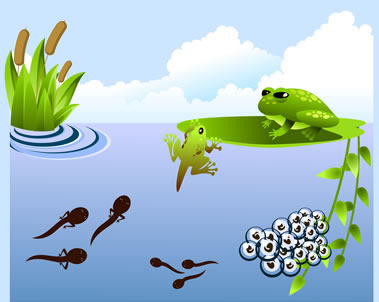- 2. Plants and animals have predictable life cycles. As a basis for understanding this concept:
- a. Students know that organisms reproduce offspring of their own kind and that the offspring resemble their parents and one another.
- b. Students know the sequential stages of life cycles are different for different animals, such as butterflies, frogs, and mice.
Introduction
All animals have life cycles. You as a human have a life cycle. When you are first born you look like a tiny human. You have two arms, two legs, a head, and a torso just like an adult human does.
Do you know if frogs look like tiny frogs when they are born? Or, do they start life quite differently? Today we will learn all about the life cycle of a frog.
A frog's life cycle looks like this.

Go through the tasks below to learn more about the frog life cycle...
Lesson/Tasks:
1. Visit the Harcourt Science text website to begin our journey. Click through each stage of the life cycle (bottom left corner) to learn about it. Please note in your science journal what the 5 stages of the frog life cycle are. Click here to begin your journey.
2. Watch the video below, Life Cycle of Frogs. List three things that you learn from the video in your science notebook. Did you notice any differences in how the life cycle stages were described compared to the what the Harcourt site described? If so, how was it different?
3. You may have noticed a big word in the frog video, Metamorphosis. Go to this dictionary site to look up the word and write down the first definition for Metamorphosis in your science notebook. Make sure to check your spelling when entering the word to look up. Enter the word at the top of the page on the site.
4. Visit this site to print out your own worksheet about the life cycle of a frog. Label the stages on the printout and bring it to class to turn in with your completed science notebook.
Extension Activities:
5. Write down a question you have about frogs or the life cycle of a frog in your science notebook. For extra-credit: try to find the answer to your question using the internet or a book. If you don't find an answer I will help you in class.
6. Ask your parent if you may visit this virtual frog dissection website. With their permission explore the various parts of the frog. Note three things that you learned in your science notebook for extra-credit.
Resources/Process:
- Links to activities are in each task. Click on the rust colored word to be directed to the link.
- Resource websites are listed in the References section.
- Students must have access to the internet for this assignment via computer or web enabled device.
- Students will need access to a printer to print one worksheet.
- Students should have their Science Notebooks and a sharpened pencil handy while working through the tasks.
- Students should follow the instructions described in each task.
Rubric:
Science Notebook tasks 1-3:
- complete, neatly written, and accurate -15 points.
- partially complete, or difficult to read, or has some errors - 10 points
- several errors and unfinished work - 0-5 points.
Task 4 -
Worksheet is printed, turned in, and correctly labeled - 5 points
Worksheet is printed, turned in but has some labeling errors - 1-4 points
Work sheet is not printed/turned in - 0 points
Extension activities 5-6 (extra Credit)
Task 5 - question is written in notebook and answered. Source of the answer is named. - 2 points
Task 6 - three observations are written regarding the frog dissection - 2 points
Total points - 20 + 4 extra credit points available.
Conclusion:
Turn in your science notebook in class when you have completed this lesson for grading.
References
Dictionary.com retrieved from http://dictionary.reference.com/.
Harcourt Science. Life Cycle of a Frog. Retrieved from http://www.harcourtschool.com/activity/science_up_close/212/deploy/interface.html.
Kid Zone. Life Cycle of a Frog Worksheet retrieved from http://www.kidzone.ws/lw/frogs/ws14.htm
MHHE. Virtual From Dissection. Retrieved from http://www.mhhe.com/biosci/genbio/virtual_labs/BL_16/BL_16.html.
Salle, Taylor. Life Cycle of Frogs retrieved from https://www.youtube.com/watch?v=xl5wpy1vZwM.


No comments:
Post a Comment